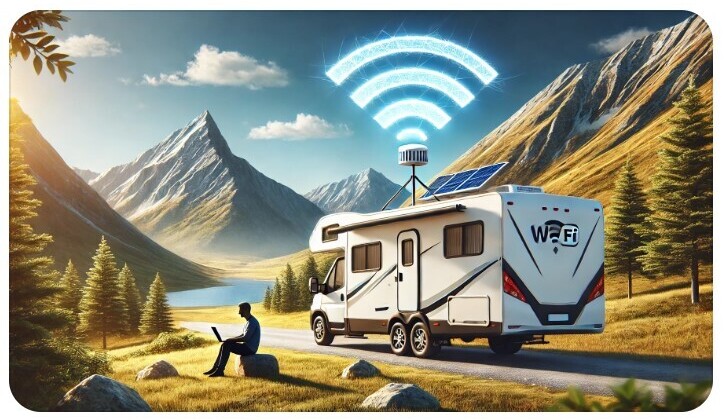These days, folks hitting the road in their RVs aren’t just looking for the next adventure; they’re also trying to stay connected with the world. It’s pretty much like taking a slice of home with you.
Whether it’s for keeping in touch with family, staying on top of work emails, or streaming your favorite shows while parked under the stars, having reliable internet is a game-changer.
RVers, you know the drill: connectivity isn’t as simple as flipping a switch. The road presents unique hurdles. Signals bounce around more than a pinball in certain spots, and sometimes, you’re truly off the beaten path. Figuring out how to maintain a decent connection while traveling can feel like piecing together a tricky puzzle.
Back in the day, folks made do with public WiFi at cafes or campgrounds, which was often spotty at best. But oh, how times have changed! Portable internet solutions have hitched a ride in the world of technology, bringing more reliable options to those with wanderlust in their veins.
So, if you keep dreaming of taking your work or binge-watch sessions anywhere, it’s not just a pipe dream anymore.
Evaluating Your Data Needs and Usage Patterns
Before you jump into gear-buying mode, you gotta understand your data needs. Everyone uses the internet differently on the road. Some might just need to check emails, while others are streaming live videos of their adventures. It’s crucial to get a handle on what kind of user you are.
Take a moment to jot down how you plan to use the internet while traveling. Are you a casual surfer, or do you have a family of streamers onboard? That answer will guide you in figuring out your bandwidth requirements.
Data caps can sneak up on you faster than you think. Underestimating your needs could lead to being throttled at the worst possible time. Make sure to choose a data plan that covers your style of usage, and always keep an eye on those data limits.
Some basic math can go a long way. Estimating how much data various activities consume and aligning that with your expected usage is a good start. This practice might sound tedious, but it saves a lot of frustration later.
Remember, staying connected and happy takes a little planning. A little foresight in understanding your data habits ensures you’ll surf the web smoothly without any unwanted interruptions.
Mobile Hotspots: A Flexible Connectivity Solution
When it comes to keeping connected on the move, mobile hotspots come in strong. They’re like your portable WiFi heroes, turning cellular signals into internet magic wherever you roam. And let’s be real, having the internet handy without being tethered to a specific location is pretty freeing.
Mobile hotspots are fantastic because they allow you to use your phone or a dedicated device to create a WiFi network. They’re flexible, adaptable, and can connect multiple devices simultaneously. Just think about working on your laptop outside your RV while streaming music on your tablet, all connected via your hotspot.
Choosing the right mobile hotspot boils down to a few essential factors. First up is coverage. Check the cellular network reach to see if it spans your travel plans.
The wider the net, the more places you stay connected. Then, consider data plans and how they fit with your usage patterns. Some plans offer unlimited data, while others cap it, which could affect your seamless connectivity.
Cost is another deciding factor. Mobile hotspots range from budget-friendly options to high-end models boasting additional features like longer battery life and better signal handling. Make sure you pick one that matches both your needs and your pocket.
Popular models like the Netgear Nighthawk or Skyroam Solis X offer a range of functionalities and price points. Take some time to read reviews and maybe even check out demos if available. Your next internet companion might be just a click away.
Satellite Internet: Bridging the Gap in Remote Areas
For those who’ve taken their RVs to truly off-the-grid places, satellite internet can be a lifesaver. When you’re parked miles from the nearest cell tower, mobile hotspots might hit their limit, and that’s where satellite shines.
Satellite internet works by connecting through a dish that communicates with satellites orbiting earth. It’s not the quickest option compared to cable or fiber at home, but it does the job when you’re away from civilization.
There are clear pros and cons to using satellite internet. It’s available pretty much anywhere with a clear view of the sky, making it perfect for remote campers. However, the setup can be more complex and costly. Installation often involves mounting a dish and pointing it correctly, which might require professional assistance.
Weather can also play a role. Storms may disrupt connections, slowing down your browsing right when you’re eager to upload those stunning landscape photos.
Some leading providers serving RV enthusiasts include HughesNet and Viasat. Both offer packages equipped for roaming adventures, with data plans that fit various needs. It’s crucial to assess these providers’ offerings to find one that meshes with your specific travel patterns.
In a nutshell, satellite internet can be a solid backup or primary option for further-flung destinations. It adds a layer of connectivity insurance when you’re in areas where nothing else seems to work.
WiFi Boosters and Antennas: Enhancing Your Connectivity
In the world of internet on the road, WiFi boosters and antennas are like unsung heroes, quietly doing their job to make everything run smoother. These gadgets step in when you’re parked at a campground with weak WiFi signals or trying to snag some local public WiFi from afar.
These devices work by picking up existing signals around you and amplifying them. A booster extends the range of an available WiFi network, making sure you stay connected even if you’re parked further from a source. Antennas, particularly those designed for RVs, increase signal strength by capturing weak signals more efficiently.
Choosing a WiFi booster or antenna doesn’t have to be overwhelming. First, identify the typical scenarios you encounter a permanent fixture can suit a full-time RVer, while a portable option might be ideal for those with varying needs. Look for devices that are easy to install and fit your setup without needing professional help.
Some popular models include the weBoost Drive 4G-X RV for enhancing cellular signals and the KING KF1000 Falcon for boosting WiFi. They come in various styles and complexities, so go for one that best matches your tech-savvy level and specific criteria.
Location matters as well. Position your antenna to maximize its ability to catch signals. Often, the higher you can place it, the better. And don’t forget, keeping the antenna free from obstructions can greatly improve its performance.
Optimizing your connectivity with boosters and antennas can be the key to hassle-free working or relaxing online—no more buffering wheels, but instead, smooth streaming and reliable browsing.
Future Trends in RV Internet Solutions
Keeping up with technology is a must, especially for the digital nomads in RVs. One of the biggest shifts on the horizon is the rise of 5G networks. With faster speeds and lower latency, 5G offers promising enhancements to mobile internet performance, making it a game-changer for travelers.
Considering the adaptability of RV life, staying current with tech trends ensures you won’t be left in the digital dust. Keeping an eye on 5G deployment can provide an edge where viable, especially since it’s gradually extending beyond urban areas into more rural territories.
Another emerging trend is the continual improvement in satellite technology. Newer satellites promise more coverage and faster speeds, addressing some of the current drawbacks like lag times and weather issues. Providers like Starlink are working towards expanding their reach, which could offer new levels of connectivity for RVers.
Smart technologies are also making their way into RV internet solutions, with smart routers and AI-driven signal boosters coming into play. These advancements are making it easier to manage and optimize internet connectivity without needing a deep technical background.
It’s always smart to keep researching and exploring the latest devices and trends. This approach opens up possibilities for improved connectivity strategies, helping you maintain a digital life while enjoying the open road adventures.
______________________________________________
To learn more about us, click here.
Please feel free to ask a question or leave a comment before you read other articles on our website.
Pam and I hope that while you enjoy the RV lifestyle, you also run an online business from your RV! We do!!
With great RV connectivity, as discussed on this website, you can easily make money while traveling to whatever destination you desire.
Would you like to create an income while enjoying RV travel?
Is there something that you are passionate about? You can create an online business that you can run anywhere. I can help you do that!









Recent Comments